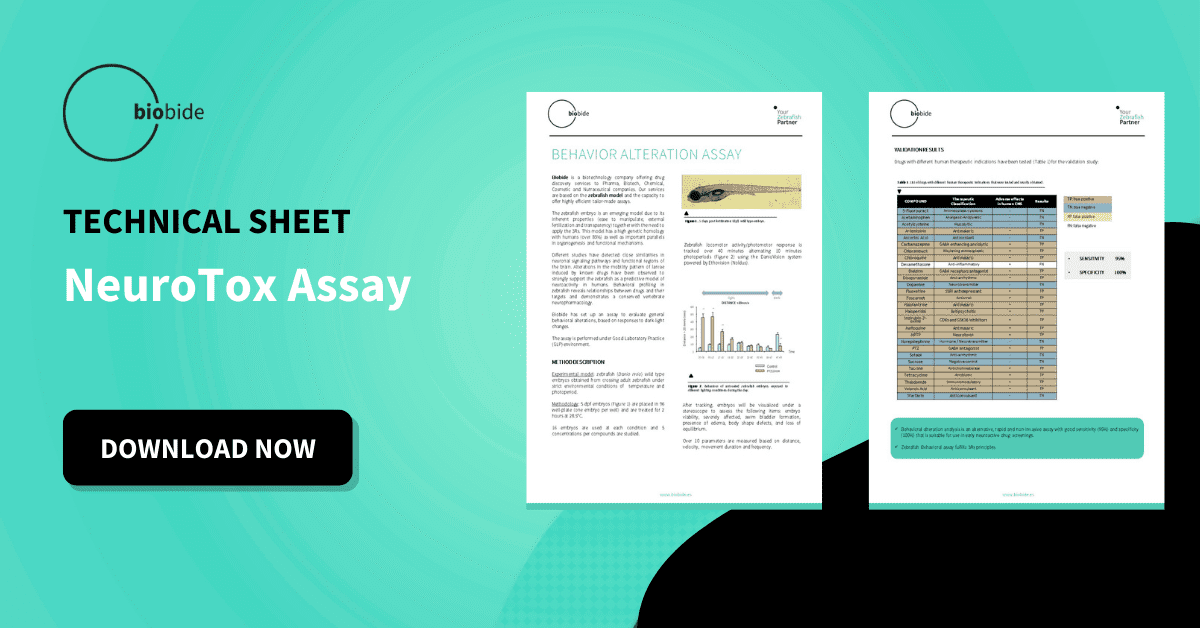The Drug Discovery process and its many stages of research are sometimes seen as an abstract science. Newly discovered compounds and unknown diseases can feel like they are only described in terms of their molecules and chemistry. Side effects and treatments end up looking like a series of equations and complex diagrams rather than a patient in a doctor’s office.
Understanding how diseases and treatments affect behavior is an important part of preclinical studies.
In reality behavior analysis is a big part of the Drug Discovery process. The formulas and math are important for objective descriptions, but it all starts with observations and experiments on living organisms. As with other tests and assays, scientists and researchers need to find an appropriate stand-in for future patients in order to accurately analyze any effects on behavior. In this article, we'll examine how Zebrafish research on behavior analysis can aid the drug discovery process.

Zebrafish as an Alternative Animal Model
Choosing the right animal model depends on the exact test and assay being performed. Some animals may be better suited for specific experiments while others struggle to provide reliable data. As a general rule, whatever is being researched needs to be comparable to humans.
While common options like rodents share many common traits with humans, they are not always the best choice. Using mammals in research involves multiple layers of government regulations, can be prohibitively expensive and doesn’t always scale very well.
On the other hand, Zebrafish are an increasingly popular choice for preclinical studies. This alternative animal model still shares significant genetics and evolutionary history with humans, while also being more naturally adaptable to the needs of research.
The small vertebrate fish have a proven track record, being used for decades in research into new treatments and diseases. However, the use of Zebrafish in behavior analysis is not as widely known. There are well-documented tests and assays that look into the hearing, sleeping disorders, addiction, hyperactivity, and more that can easily be applied to preclinical studies.
Zebrafish behavior analysis tests have comparable counterparts for common tests used with rodents and other animal models.
Dark and Light Behavior Alteration Assay
Zebrafish are a diurnal species regulated by homeostatic and circadian mechanisms. They have a highly conserved circadian system in which melatonin is the main hormone involved.
When zebrafish embryos are exposed to different stimuli of light and dark periods, they experience moments of hyperactivity during the light periods and hyperactivity during the dark periods. Any behavior alterations falling out of this pattern can be associated with neuroactivity or neurotoxicity.
Conditioned Place Preference
The Zebrafish version of the classic experiment involves a series of small rooms to test positive rewards and negative punishments. The animal models are presented with the choice of entering a room with a reward – usually some kind of special treat – or a punishment – a minor annoyance.
The fish are then observed as they choose between the variable room and the neutral control room. Like with rodents, Zebrafish prefer to receive rewards and avoid punishments, allowing scientists to look into their behavior and extrapolate how the data could be applied to humans.
Diving Response Test
The inherent differences between an aquatic organism like Zebrafish and land mammals such as mice – or even humans – would lead some to think their unique behaviors are incompatible or not comparable. The biology of a fish adapted to life underwater could be seen to simply be too different to live on the surface. However, that could not be further from the truth, as seen in examples like the diving response test.
A specific behavior to Zebrafish and their aquatic environments is how they have a natural tendency to dive to the bottom of a new tank. The small fish are known to stay at the bottom until they are more comfortable with the new setting and begin exploring the rest of the habitat.
Taking a longer time to become comfortable enough to swim around a new tank is associated with higher levels of anxiety.
While obviously a very different habitat, the behavior is remarkably similar to thigmotaxis observed in rodents. Like Zebrafish diving to the bottom of a new tank, rodents will cling to the edges of a new field until they are comfortable with the habitat. The more time it takes for the small mammals to begin exploring the rest of the area is also associated with higher levels of anxiety.
Bite Test
Another example of behavior specific to Zebrafish is how the small fish like to use exploratory biting. When presented with a new object, the fish will instinctively bite at it to learn more about what the new thing in their habitat is. Only when they are more familiar with the object will the biting begin to stop, allowing for observations on what the fish consider new objects and what they consider familiar objects.
The bite test with Zebrafish is comparable to novel object recognition tests performed on rodents. Like with Zebrafish, the small mammals are known to spend more time with new objects placed in their habitats. The idea is they can clearly recognize which objects are new and which they have already explored.
Rotating Drum Concealment Assay
Zebrafish have a natural instinct to hide in small enclosed spaces they are familiar with when they are threatened. The rotating drum concealment assay relies on this behavior by placing a colored vertical band on a rotating drum with a small cylinder in its center. Zebrafish are encouraged to find the familiar comfort of the enclosed space and the results provide information on how their vision is affected by any potential treatments.
While hiding in small spaces underwater may be a unique Zebrafish trait, mice are known to have a very similar instinct as well. When threatened, the small mammals will look for known hiding spots until they feel safe.
Benefits of Zebrafish Behavior Analysis
Zebrafish behavior analysis comes with all the well-established benefits of working with the small vertebrate fish. With hundreds of transparent embryos every week, researchers can focus on the science and perform more tests and assays in preclinical studies.
Zebrafish are a reliable alternative animal model that is highly comparable to humans while also being cost effective and easy to scale.
The Zebrafish behavior analysis tests outlined above can be performed on either embryos or adult fish. Zebrafish embryos in particular offer unique advantages for early Drug Discovery.
Their fully transparent membranes allow for direct observations in an ethical manner while increasing sample sizes. Relying on embryos also leads to more cost effective experimentation simply by requiring less of the compound to perform tests and assays.
A notable benefit to relying on Zebrafish embryos is how the entire process can be automated.
The early stages of Drug Discovery often require large scale testing and lead to innumerable dead ends before a promising new treatment can begin to move forward. With mammals like rodents, behavior analysis grinds to a very slow pace and costs begin to skyrocket as more time and money is spent on maintaining the animal models and fewer hits can be accurately tested.
Zebrafish behavior analysis is streamlined, cost effective, and scalable.
Zebrafish are an alternative animal model that provides relevant data and allows research to move faster. Getting new treatments from the lab to the hospital means working through every stage of the Drug Discovery process and understanding as much as possible about the new drug’s toxicity, safety, and efficacy. Zebrafish can help make that journey a bit easier as new medicine makes its way around the world.





